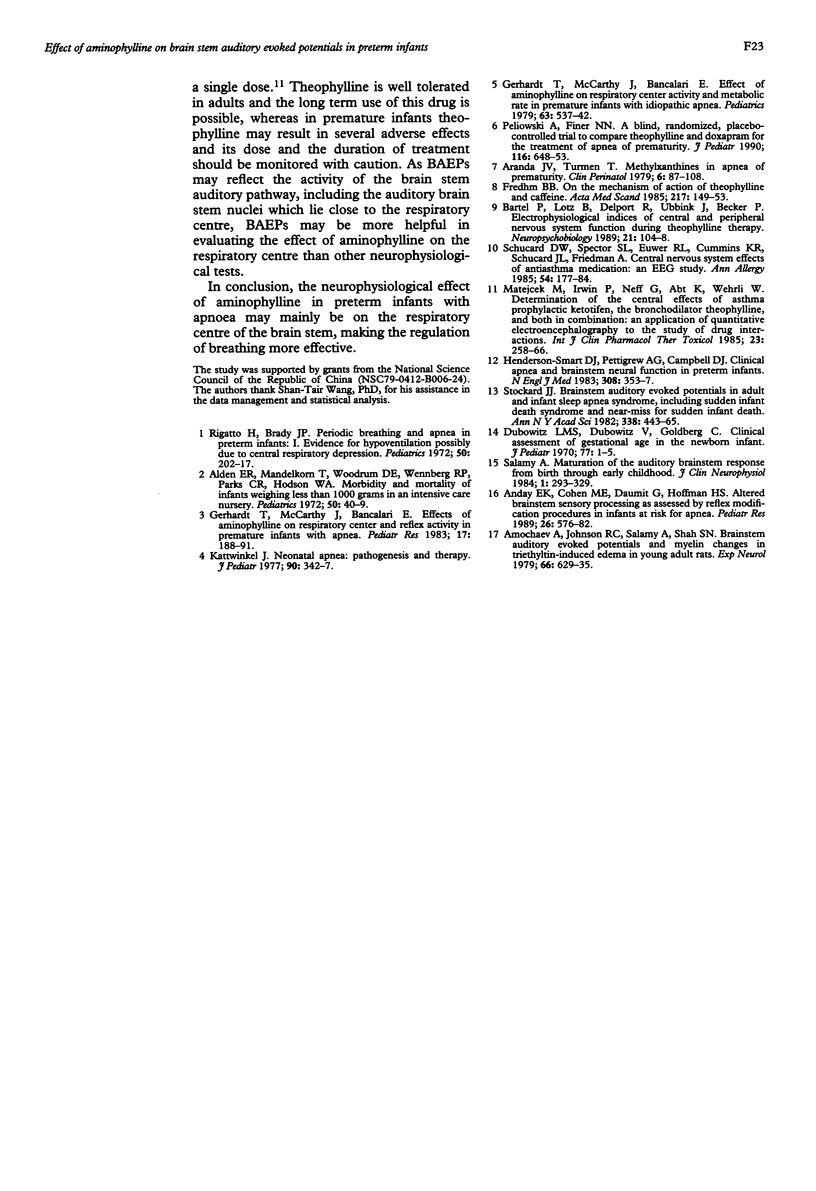Abstract
To determine the neurophysiological effects of aminophylline on apnoea of prematurity, the brain stem auditory evoked potentials (BAEPs) of 30 apnoeic infants and 34 age matched controls were evaluated and compared. After six days of treatment with aminophylline, the brain stem conduction time (interpeak latency of I-V) in apnoeic infants decreased compared with controls of a similar postconceptional age. The mean latencies of the peaks and interpeaks of all waves except wave I were significantly lower in the apnoeic infants after than before receiving aminophylline. No significant differences were found in the latencies of BAEPs between the apnoeic infants who responded and those who did not respond to aminophylline treatment, however. These results suggest that aminophylline may enhance conduction along central auditory pathways and stimulate the regulatory effect on the respiratory centre of the brain stem.
Full text
PDF



Selected References
These references are in PubMed. This may not be the complete list of references from this article.
- Alden E. R., Mandelkorn T., Woodrum D. E., Wennberg R. P., Parks C. R., Hodson W. A. Morbidity and mortality of infants weighing less than 1,000 grams in an intensive care nursery. Pediatrics. 1972 Jul;50(1):40–49. [PubMed] [Google Scholar]
- Amochaev A., Johnson R. C., Salamy A., Shah S. N. Brain stem auditory evoked potentials and myelin changes in triethyltin-induced edema in young adult rats. Exp Neurol. 1979 Dec;66(3):629–635. doi: 10.1016/0014-4886(79)90208-5. [DOI] [PubMed] [Google Scholar]
- Anday E. K., Cohen M. E., Daumit G., Hoffman H. S. Altered brainstem sensory processing as assessed by reflex modification procedures in infants at risk for apnea. Pediatr Res. 1989 Dec;26(6):576–582. doi: 10.1203/00006450-198912000-00012. [DOI] [PubMed] [Google Scholar]
- Aranda J. V., Turmen T. Methylxanthines in apnea of prematurity. Clin Perinatol. 1979 Mar;6(1):87–108. [PubMed] [Google Scholar]
- Bartel P., Lotz B., Delport R., Ubbink J., Becker P. Electrophysiological indices of central and peripheral nervous system function during theophylline therapy. Neuropsychobiology. 1989;21(2):104–108. doi: 10.1159/000118561. [DOI] [PubMed] [Google Scholar]
- Dubowitz L. M., Dubowitz V., Goldberg C. Clinical assessment of gestational age in the newborn infant. J Pediatr. 1970 Jul;77(1):1–10. doi: 10.1016/s0022-3476(70)80038-5. [DOI] [PubMed] [Google Scholar]
- Fredholm B. B. On the mechanism of action of theophylline and caffeine. Acta Med Scand. 1985;217(2):149–153. doi: 10.1111/j.0954-6820.1985.tb01650.x. [DOI] [PubMed] [Google Scholar]
- Gerhardt T., McCarthy J., Bancalari E. Effect of aminophylline on respiratory center activity and metabolic rate in premature infants with idiopathic apnea. Pediatrics. 1979 Apr;63(4):537–542. [PubMed] [Google Scholar]
- Gerhardt T., McCarthy J., Bancalari E. Effects of aminophylline on respiratory center and reflex activity in premature infants with apnea. Pediatr Res. 1983 Mar;17(3):188–191. doi: 10.1203/00006450-198303000-00003. [DOI] [PubMed] [Google Scholar]
- Henderson-Smart D. J., Pettigrew A. G., Campbell D. J. Clinical apnea and brain-stem neural function in preterm infants. N Engl J Med. 1983 Feb 17;308(7):353–357. doi: 10.1056/NEJM198302173080702. [DOI] [PubMed] [Google Scholar]
- Kattwinkel J. Neonatal apnea: pathogenesis and therapy. J Pediatr. 1977 Mar;90(3):342–347. doi: 10.1016/s0022-3476(77)80691-4. [DOI] [PubMed] [Google Scholar]
- Matejcek M., Irwin P., Neff G., Abt K., Wehrli W. Determination of the central effects of the asthma prophylactic ketotifen, the bronchodilator theophylline, and both in combination: an application of quantitative electroencephalography to the study of drug interactions. Int J Clin Pharmacol Ther Toxicol. 1985 May;23(5):258–266. [PubMed] [Google Scholar]
- Peliowski A., Finer N. N. A blinded, randomized, placebo-controlled trial to compare theophylline and doxapram for the treatment of apnea of prematurity. J Pediatr. 1990 Apr;116(4):648–653. doi: 10.1016/s0022-3476(05)81620-8. [DOI] [PubMed] [Google Scholar]
- Rigatto H., Brady J. P. Periodic breathing and apnea in preterm infants. I. Evidence for hypoventilation possibly due to central respiratory depression. Pediatrics. 1972 Aug;50(2):202–218. [PubMed] [Google Scholar]
- Salamy A. Maturation of the auditory brainstem response from birth through early childhood. J Clin Neurophysiol. 1984 Jul;1(3):293–329. doi: 10.1097/00004691-198407000-00003. [DOI] [PubMed] [Google Scholar]
- Shucard D. W., Spector S. L., Euwer R. L., Cummins K. R., Shucard J. L., Friedman A. Central nervous system effects of antiasthma medication--an EEG study. Ann Allergy. 1985 Mar;54(3):177–184. [PubMed] [Google Scholar]
- Stockard J. J. Brainstem auditory evoked potentials in adult and infant sleep apnea syndromes, including sudden infant death syndrome and near-miss for sudden infant death. Ann N Y Acad Sci. 1982;388:443–465. doi: 10.1111/j.1749-6632.1982.tb50808.x. [DOI] [PubMed] [Google Scholar]


